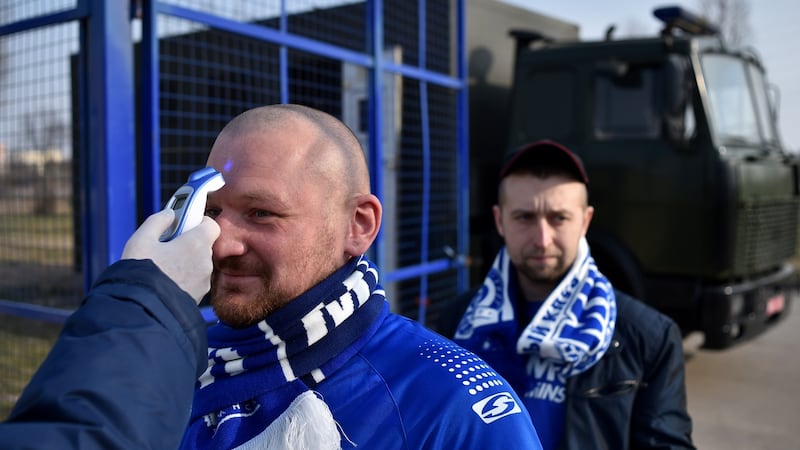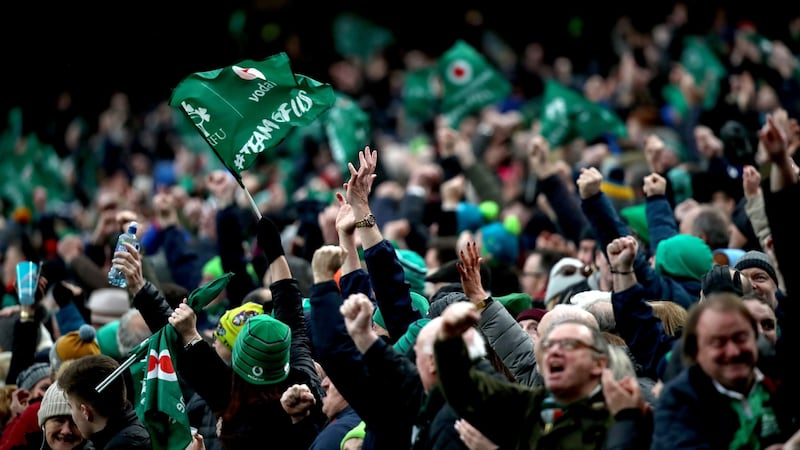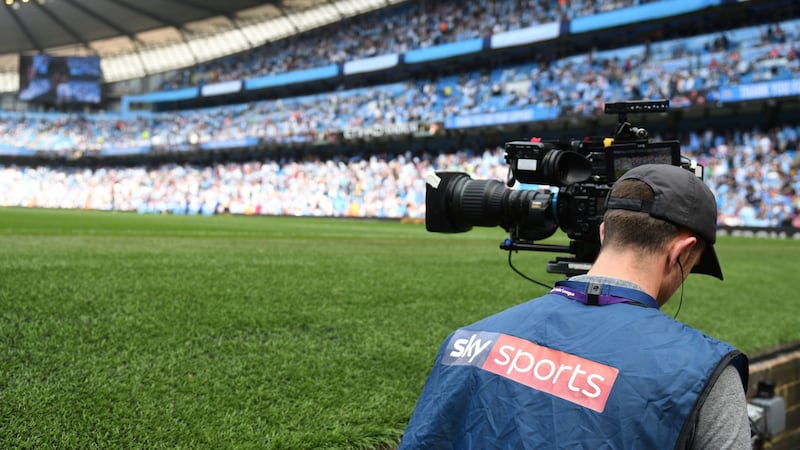At this stage the buzz words and phrases roll off the tongue. “Flatten the curve”, “stay the course”, “the R value” and so on. This is the language of the pandemic. No matter how hard you try it’s impossible not to let some of them slip out every now and again.
One of the phrases thrown around more than most is “the new normal”. We’re not going back to normal, pre Covid-19 lives, but instead entering a “new normal”, or so we’re told.
Where sport fits into this new normal is anyone's guess and a question that seems to bring up more bizarre ideas by the day – just this week the Premier League were talking about perhaps playing halves of less than 45 minutes. It's only last month that the National Rugby League in Australia were supposedly looking at housing all players and officials on a quarantined private island.
One element of the sports world which has been largely left out of these conversations is the fan. Where does the humble match-going/non-match-going/TV-viewing fan stand in all of this? Is there space for us in the new sporting world while coronavirus is still at large? Or is it a waiting game until an effective treatment is found? Even then, when Covid-19 is confined to history, just how different will the landscape be for a fan compared to how it was just three months ago when Liverpool were hurtling towards a first Premier League title in 30 years, when a packed Aviva Stadium watched Ireland beat Wales in the Six Nations, when League of Ireland fans up and down the country were just getting back into the swing of things after the longest off-season in Europe?
Crowds
Although there is still little known about the virus one thing that was learned quite quickly is that, in crowds of people packed closely together, it can spread rapidly.
Among all of the restrictions that have been introduced in the Republic and which are set to slowly begin lifting from May 18th onwards, the consistent advice throughout and which is likely to continue long after the final phase begins on August 10th is to remain two metres away from people and to regularly wash hands.
Think for a minute about a stadium full of fans and neither of those actions spring to mind. Being closely packed together and feeling the ups and downs of a match through the people around you is what being a fan in a stadium is about. It is a key part of the experience and being spaced two metres apart would only nullify that. However, shouting, roaring and celebrating when your team scores has the potential to spread a lot of virus. As for regular hand-washing, well it's fair to say that the sinks in places such as Croke Park and the Aviva Stadium don't get used quite as much as they perhaps should.
“It depends how well you could socially distance by having people sitting two metres apart,” says Dr Clíona Ní Cheallaigh, a consultant in general medicine and infectious diseases at St James’s Hospital.
“The big risk would be when people are touching things, so all the door handles, going to the toilet in Croke Park, going to the bar or wherever it can pass from somebody touching something to somebody else touching something. We’d need to really up our game on hand hygiene and wiping things down hugely. And certainly I’d think indoor events wouldn’t be possible until we have a vaccine probably.
“Those motion sensor doors and, in toilets, the taps that don’t need to be pressed, that you just put your hand under, will probably be a big part of when we go back to normal. Those things are very good anyway because they stop the spread of all kinds of diseases whether it’s the vomiting bug or the flu.”
Phase five of the Government's exit plan, which is due to kick in on August 10th, does say that "sports spectatorship which involves mass gatherings" will be permitted but only in accordance with restrictions on numbers and if social distancing can be complied with. As is the case with much of the plan there is no more detail provided but the social distancing aspect alone would surely make it all but impossible in small GAA or League of Ireland grounds while venues such as Croke Park or Lansdowne Road – with wide concourses and plenty of toilets – might be able to cater for a small crowd.
Other measures such as wearing masks and temperature checks for fans entering the stadium can help to limit the spread of the virus but Ní Cheallaigh says that, on their own, they do not eliminate the risk.
“It’s like the Swiss cheese theory. So for something to go wrong the hole in the cheese has to go through the whole slice. So if you’ve a thin slice of Swiss cheese the holes go all the way through and if you have a thick enough slice not all of the holes go all the way from one side or the other.
“So you can put lots of things in together that aren’t 100 per cent and together they may work and reduce that risk right down but on its own the slice is thinner and won’t work. People with coronavirus may have had a temperature earlier in the day or they may not have a temperature at all but checking them at one point in time for their temperature isn’t going to pick them all up by any means.”

So, by all accounts it’s looking almost certain that stadiums won’t be full again until a vaccine or effective treatment has been found for Covid-19 and the very best option might be to hope for limited, socially distanced crowds in stadiums before the end of the year.
But who would want to go?
A recent opinion poll from Reuters/Ipsos showed that only about 40 per cent of "avid" fans in the United States would go to see their team play before a vaccine has been developed. Another 40 per cent said they were willing to wait for a vaccine, even if it takes more than a year, while the remaining 20 per cent either said they did not know what they would do or, more worryingly, would never attend such events again.
A similar survey carried out by Seton Hall University in New Jersey showed that 61 per cent of fans would not be comfortable attending sports events before a vaccine is developed.
It only takes a short walk around your immediate area or a trip to the supermarket to see that there is genuine concern among people about being too close to others. Moving on to the road or walking in single file to give people two metres of space have very quickly become social norms and even when a vaccine is developed and restrictions are gone completely, will people suddenly revert to type and flock back to crowded pubs, stadiums and music venues? As Dr Shane Timmons of the Behavioural Research Unit at the Economic and Social Research Institute (ESRI) explains, the longer we do these things the more they become ingrained in society.
“What this pandemic gives us is that actually people can change their behaviour very quickly, you just need a strong enough motivation to be there. The change in social norms has been very fast and fairly drastic, the question is how much of that is likely to stick when things start to go back to normal. The longer this goes on the more likely it is that habits will stick.
“There are some things we’re doing at the moment that might be likely to stick around longer. So coughing into the crook of your elbow, being aware that when you touch a surface out in public you might pick something up off it – those things might be likely to stick around for longer. I think there’s been some reports even that covering your nose or mouth when you sneeze or cough didn’t come about as normal behaviour until the Spanish Flu [in 1918] whereas that’s something that’s normal behaviour now.
“What’s difficult about habits and how we’re acting in a crowd at the moment is that we don’t have any of these replacement behaviours because none of us are interacting in crowds so we’re not building them up. At the moment we might be conscious of keeping a 2m distance away but if we’re in a situation where that’s not possible you’d imagine that’d make people feel uneasy to begin with. And there might be spillover from other habits so if you’re in a crowd and you hear or see someone who has coughed without doing it into their elbow other people might not be too happy with that, they might frown upon it.”
Affordability
And what of the financial impact? Attending sporting events has become a more and more expensive endeavour and many fans have already been priced out, particularly in English football.
The latest figures show about 800,000 people in Ireland are now totally dependent on the State for their financial survival while another 427,000 are having their wages subsidised by the Government. Some economists are predicting that the impending recession will rival the Great Depression of the 1930s.
Where does buying a ticket for a match figure in all of that? Last year Ireland played England and France in the Six Nations at the Aviva Stadium. For both matches the majority of seats in the upper and lower tiers of the east and west stands were priced at €115 which continued the trend of prices rising each time Ireland played those opponents every two years. They were the most expensive tickets prices ever set by the IRFU and were some of the most expensive for any sporting event ever held here.
In 2009, when the global economy was in freefall, tickets to see Ireland play England and France in the Six Nations averaged out at around €85 for a seat in Croke Park. In the same year the GAA froze ticket prices after revenue from sales had fallen by €5.1 million the previous year, while the FAI also announced a freeze on prices for international matches until 2012.

Ireland are due to play France and England in Dublin in next year's Six Nations and while it is anyone's guess as to whether those matches will go ahead with crowds in attendance, would the IRFU be able to charge €115 for a ticket in the corner of the upper east or west tier in Lansdowne Road? Given that the organisation is financially dependent on full houses for a minimum of five home internationals each year and as they are set to lose at least €10 million if rugby does not return in 2020, it will be a tough balancing act to price accordingly.
On a similar note, the GAA upped All-Ireland final ticket prices to €90 last year in what was the first increase since 2011. It's hard to ever envisage All-Ireland final tickets not selling out but almost €100 just for a ticket, never mind food or drink or anything else, looks quite steep when unemployment rates are skyrocketing and the economy is predicted to contract by eight per cent.
For organisations such as the IRFU, the GAA and the FAI, matchday revenue is paramount to their survival and they will all need buy-in from fans to recover from the current crisis. Across the water in the Premier League it is a different story.
While matchday revenue is important its overall impact has fallen from 43 per cent of total Premier League income in 1992/93 to just 13 per cent today. As is the case when it comes to many of the Premier League's financial league tables, Manchester United sit top after they generated £111 million (€127m) in income from matchdays last year.
If, as clubs are already planning for, the whole of the 2020/21 season had to be played behind closed doors, Arsenal would suffer the most after their matchday incomes accounted for almost 25 per cent of their total income last year – seven per cent more than Spurs who are second in that chart.
Incidentally the two north London rivals also have the most expensive season tickets in the league with Arsenal’s averaging at £1,330 (€1,524) and Spurs at £1,395 (€1,598). Playing behind closed doors for a season would obviously have a huge impact but could that also be followed with the second hit of fans not being able to afford those prices or choosing to spend their money elsewhere?
"The 2007 recession is nothing compared to what we're going to go through this year," says Kieran Maguire who is a football finance lecturer at the University of Liverpool.
“Clubs are going to have to work extremely hard to maintain their levels of income. If you look at the three sources – in terms of matchday some fans won’t be able to afford to go to matches and when they do go to matches it might be that you go there, you watch the match and you go home whereas previously you might have used some of the catering, you might have bought some of the merchandise or things of that nature.
"You've got clubs such as Bournemouth who have an 11,000-capacity stadium and only £4 out of every £100 comes from matchday ticket sales so they'll probably be okay but I think the middle-tier clubs like Leicester, Southampton, West Ham, Everton and so on – they're going to have to work harder because they have core working class fanbases who are likely to be hit by the recession and therefore, football ultimately is a luxury. If we work on the basis that four million people [in the UK] could be unemployed by the end of the year and a lot of those people are football fans then the only way to attract people in is to drop the prices."
The sports-TV landscape
In the short-term some fans have, at least, felt an ease on their pocket by pausing their subscriptions to the likes of Sky Sports and recent talk that some of this season's remaining 92 Premier League matches could be shown free-to-air is something to look forward to for everyone.
However, in the Premier League at least, it is generally acknowledged that the huge television deal is the main driver in everything and that any impact on the current deal valued at more than £5 billion (€5.7bn) would hit everything from transfer fees to wages and ticket prices.
The last two deals have plateaued and the next, which begins in 2022, may well dip in value as a response to the impending financial crisis but it is expected to remain fairly steady.

“In terms of TV deals, if there’s a global recession then less people can afford to pay TV subscriptions so TV companies have less money to spend themselves,” says Maguire.
“Over here, and it’s the same in Ireland, if you look at the price of your Sky subscription it’s gone up and up and up ahead of inflation. There’s no way they can justify that for the next few years so they won’t be in a position to offer more money. I don’t think the bubble will burst but the opportunities for growth that did exist won’t exist for a good few years.”
Sport is one of the few markets in broadcasting where traditional live TV still remains the kingpin – in the UK and Ireland anyway – which is mainly due to rights being sewn up by traditional subscription-TV companies. However, a move towards streaming services is inevitable and may well be sped up if the current situation continues for much longer and ends up costing Sky and BT a combined total of more than €1 billion, as some have predicted it will.
This season Amazon Prime became the first streaming service to break into the Premier League market in the UK by showing 20 matches live on their service in December and January. While those matches were broadcast on television via Premier Sports in Ireland, the reaction in the UK was positive with little or no glitches along the way, even for fans with limited broadband speeds.
Just last month the US company confirmed themselves as the big winners from the coronavirus pandemic by announcing that they are currently bringing in $33 million an hour while traditional retailers' doors are shut. Whether or not they target more Premier League rights when the current deal comes around for renewal remains to be seen but one thing for certain is that they will have a lot of money to throw around.
US streaming company DAZN – which has made its name broadcasting boxing in the US and counts Katie Taylor as one of its contracted fighters – was due to launch in the UK and the Republic recently but pushed back due to the current situation. Set to be priced at around €5 a month, many in the industry believe they will find their feet over the next couple of years before also targeting Premier League rights in the next TV deal auction, giving the traditional players more competition to fight off.
"The whole business model of pay-TV seems a bit dated now versus streaming services," says Jake Bickerton, who is the editor of trade magazine Broadcast Sport.
“This could be a bit of a catalyst for your traditional sports fan who is used to just paying for Sky to maybe look into stopping that at the moment and when live sport comes back again there might be alternatives that are a bit more flexible in terms of the monthly costs such as pay-as-you-go or small subscriptions versus these quite hefty costs that people have had to pay in the past.
“You’ve got Amazon who have already made a move and they’re not going to be short of cash, if anything they’ll have even more than before. This could be their moment to really go for it with the next rights deal. Sky and BT are definitely going to be hit hard by this period so it does open the doors for others to come in.”



















